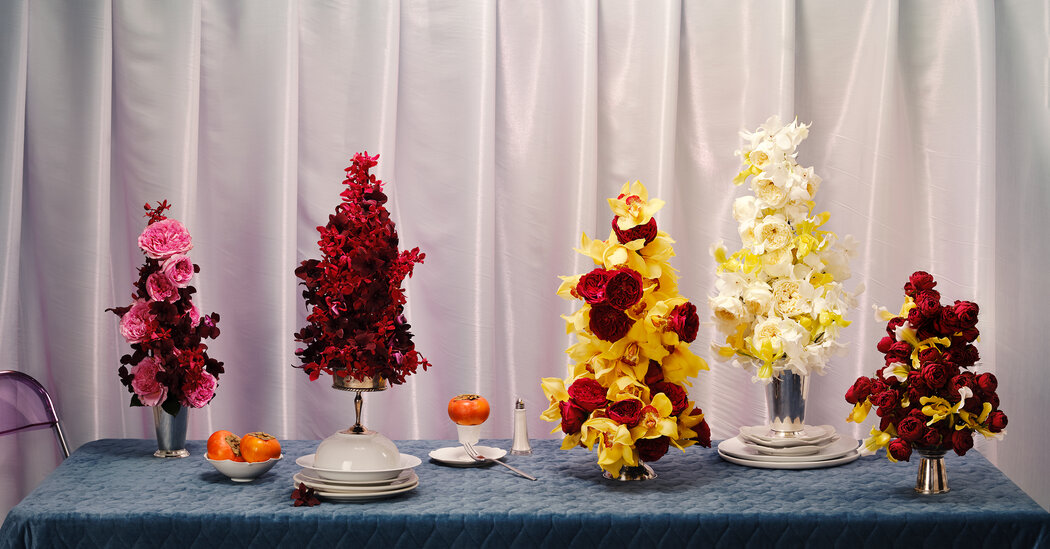“I have so much admiration for florists who can make haphazard, wild arrangements,” says Miguel Yatco, 30, the floral artist behind the Brooklyn-based studio Agos Muni. “But it’s different to how I approach things: I’m rigorous.” The compositions he produces for his fashion and design world clients — a column of billowy cream-and-orange poppies for the French fashion house Hermès; a three-foot-high mass of deep purple hydrangeas and clematis for the New York design gallery Jacqueline Sullivan — are often so tall and tightly packed that they resemble inverted cumulonimbus clouds. “I love to create the feeling of the flower floating and defying gravity,” says the designer, who likes to begin with a vessel, often a silver pedestal bowl or oversize pewter julep cup, then adds blooms to double or triple its height.
If last summer saw the culmination of a trend for sprawling, low-lying floral landscapes, Yatco’s work represents an aesthetic about-face. Increasingly, arrangements seem more orderly than meadowlike, their precise structures clearly shaped by human hand and their blooms, whether lush and densely grouped or spare and few, visibly contained by vases. When the world outside feels turbulent, they seem to remind us, we tend to tighten our grip. But these works are also defined by their height, their long stems often extending above or through equally elongated vessels. In their ascent there is optimism: If there are constraints on all sides, then the only way is up.
In September, when the Italian fashion house Bottega Veneta opened its remodeled Paris store, its tables were topped with plumes of flowers that practically touched the ceiling. Their creator, the Brussels-based French floral artist Thierry Boutemy, 55, had drawn inspiration from the still lifes of heaping multicolor arrangements painted by the Flemish and Dutch masters around the time of tulip mania, when that flower’s popularity soared in early 17th-century Europe. Taking cues in particular from the vivid palette of “A Still Life of Flowers in a Wan-Li Vase” (circa 1609) by Ambrosius Bosschaert the Elder, he conceived a series of vibrant vertical arrangements, each assembled from fat heads of purple-and-blue hydrangeas, speckled yellow lilies, wavy-stemmed yellow nerines and, finally, purple delphiniums and yellow eremurus. Compared to the bouffant-like silhouettes of Bosschaert’s assemblages, Boutemy’s were narrow, continuing the line of the cylindrical Venetian bubble-glass vases that held them. “Rigor and clarity are the most important things,” Boutemy says, and an elongated shape means “each flower remains visible and each gives strength to another.”
But upright arrangements needn’t be grandiose to be striking. The willowy single-stem and single-variety displays that the Connecticut-based ceramic artist Frances Palmer, 67, creates with the flowers she picks from her garden in warmer months — pairing them with her elegant pottery, often inspired by ancient Etruscan and Cycladic forms — are dramatically simple. “I like everyone to have their cameo,” she says of her approach, which might showcase a sword-shaped ‘Peter Pears’ apricot gladiolus in a narrow-necked blue celadon vase or a pair of velvety dark red ranunculus whose stalks stretch high above a small, urnlike vessel. Palmer generally leaves stems, especially the snaking ones of her garden’s poppies, long and exposed: “I think they’re equally important,” she says.
“It’s the way they sit, bend and twist in the vase,” says the London-based florist Christie Leigh, 35, whose minimalist style often channels the deliberate, restrained forms of ikebana, the traditional Japanese art of flower arranging. For a recent breakfast in London, she used silver dessert bowls to anchor spindly arrangements of chocolate cosmos, pink scabiosa, ranunculus and white anemone. “It was morning, so we wanted everything bright and breezy,” she says of her decision to display the blooms’ rangy naked stems at varying heights. To hold her flowers in place, Leigh often uses a kenzan, an ikebana tool that resembles a spiked metal plate, or narrow vessels that provide support. For the newly opened Italian restaurant Dalla in East London, she sourced silver candlestick-shaped vases attributed to the Viennese designer Carl Auböck, furnishing each with a single, barely trimmed stem of white ‘Butterfly’ ranunculus.
The London-based florists Iona Mathieson, 30, and Romy St. Clair, 33, of the studio Sage Flowers, also create distinctive vertical arrangements, but with an emphasis on unexpected juxtapositions of color and scale. A recent asymmetrical composition featured a low cluster of pale mauve lisianthus on one side and, on the other, an explosion of blush dahlias, several of them kept exaggeratedly tall, shooting skyward like fireworks. “You’re not trying to mimic how things look in nature,” St. Clair says. And yet the delicate outstretched stems of these towering arrangements highlight perhaps the most beautiful thing about flowers: their ephemerality.
Photo assistant: Omer Kaplan. Set designer’s assistant: Joseph McCagherty







